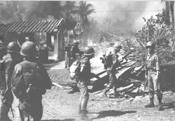- Exhibits
- Tet Offensive
- Aftermath
The Tet Offensive (Tết Mậu Thân)
- The Tet Offensive (Tết Mậu Thân)
- Hue: The Imperial City
- The Battle of Khe Sanh
- The Battle for Saigon
- Aftermath of the BattlesPolitical ConsequencesExhibit Credits
Aftermath of the Battles

Vietnamese Rangers on operation to rout the Viet Cong between Binh Tien Bridge and Binh Tay alcohol distillery in Cholon, February 5, following attacks on the capital city and other areas of the Republic during the festive TET holiday period.
(Douglas Pike Photograph Collection [va000460])During the early fighting of the Tet Offensive, the Viet Cong successfully exploited the element of surprise and succeeded in striking more than one hundred towns and cities throughout the Republic of Vietnam. As the initial shock of the attack began to wear off, however, the Americans and South Vietnamese were able to bring their firepower to bear against the communist attackers and virtually annihilated them. Thus, in the aftermath of the fighting, it became immediately apparent that the Tet Offensive and the battle of Khe Sanh had both been tactical disasters for the communists. Of the 84,000 communist soldiers who participated in the fighting, some 45,000 were killed. Such a high casualty rate effectively wiped out the Viet Cong as a fighting force, and from that point on, the war became primarily an NVA (North Vietnamese Army) affair. In addition to the massive casualties, the general uprising that the communists had planned for did not materialize. As a result, communist morale suffered a significant setback. The North Vietnamese had always believed that they were fighting to free the South Vietnamese from foreign occupation, but the fact that they did not join them in their fight against the Americans shattered many of their illusions. Despite the lack of an insurrection and the setbacks that they suffered from Tet, the North Vietnamese emerged from the battles more determined than ever to expel the Americans and unite all of Vietnam under their rule, particularly after learning of the reaction to the offensive on the American home-front.
Read More:- Miscalculation! Communists Turn Tet Holiday Truce Into Treacherous Terror Offensive That Failed (12 pages) [01 February 1968] - 2131012063(see full record)
- Forward! Final Victory Will Be Ours! DRVN Government Report at the National Assembly (Third Legislature, Fourth Session - May 24, 1968) (60 pages) [24 May 1968] - 2391005002(see full record)
Vietnam Center & Sam Johnson Vietnam Archive
-
Address
Texas Tech University, Box 41041, Lubbock, TX 79409 -
Phone
(806)742-9010 -
Email
vnca@ttu.edu

